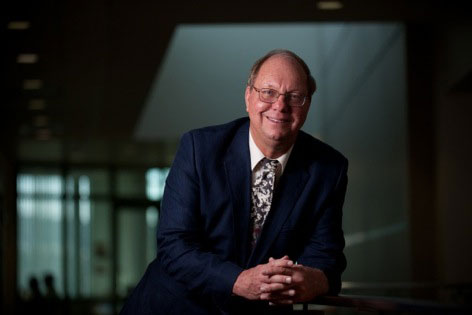
|
|
UC Irvine is turning the corner on autism

Center unites multidisciplinary experts in drug discovery effort
With $14 million from the William & Nancy Thompson Family Foundation and the Children & Families Commission of Orange County, UC Irvine is helping lead the charge against a disorder that affects about 1 in 88 children in the U.S. – autism.
The funding created the Center for Autism & Neurodevelopmental Disorders of Southern California, which will provide unparalleled access to assessment, diagnosis, care coordination, family support and education for children, teens and young adults.
Along with facilitating this continuum of care, the generous funding will augment an aggressive UC Irvine research campaign to find new treatments that is affiliated with the new center.
“In addition to all that the Center for Autism & Neurodevelopmental Disorders of Southern California will offer, we must stand behind world-class research,” says William Thompson, chairman of the William & Nancy Thompson Family Foundation. “This is taking place right now at UC Irvine. Real breakthroughs must start with research that is directed toward novel treatment approaches, and the research team at UC Irvine is distinctively set up to do this. These efforts walk hand in hand with our clinical, educational and advocacy efforts.”
Under the leadership of Dr. J. Jay Gargus, professor of physiology & biophysics and pediatrics, the Center for Autism Research & Translation will launch an innovative drug discovery effort uniting multidisciplinary campus scientists in a common purpose: to develop an effective pharmaceutical therapy for the core deficits of autism.
“UC Irvine has world-class molecular geneticists, biophysicists, neurobiologists, behaviorists, pharmacologists and clinical researchers, many of whom are already engaged in the study of autism and are excited by the opportunity to work together in an integrated program,” says Gargus, a nationally recognized metabolic/genetic specialist.
“CART presents a distinctive chance to have a transformational and lasting impact on autism worldwide because of our focus on how molecular, cellular and brain functions are altered and how drugs affect each level. We are confident that the program and its goals are feasible because all of the necessary pieces are already in place at UC Irvine.”
The center’s role is particularly important today, he says, because major pharmaceutical companies have mostly neglected autism, and breakthroughs in decoding the human genome are now providing researchers an unprecedented opportunity to understand the innermost workings of autism.
More than a decade ago, it was discovered that cancer is a genetic disease, making the defective genes a target of drug discovery campaigns – and resulting in the first round of cancer drugs specific to the molecular lesion. Thus began an optimistic new era of cancer treatments.
Gargus thinks autism research is at a point where it can begin duplicating the trajectory of cancer research. “It is now clear that most autism, like cancer, has a genetic basis and that while rare forms of both are caused by mutations in single genes, many defective genes in a pathway generally need to work together to produce disease,” he says.
By determining the mechanisms by which malfunctioning genes affect the common neural pathways linked to autism, Gargus believes, it will be possible to design or repurpose existing drugs to normalize the function of those channels. Like cancer therapy, this may well require a synergistic cocktail of drugs that act on distinct but interacting targets.
Three separate drug discovery efforts by UC Irvine neuroscientists involving these neural pathways are being integrated into CART.
Pharmacology professor Kelvin Gee is testing compounds that stabilize the firing rate of brain cells; psychiatry & human behavior professor Gary Lynch is using molecules called ampakines to increase growth factors in brain cells that allow for normal signaling; and Daniele Piomelli, the Louise Turner Arnold Chair in the Neurosciences, is finding that boosting natural, marijuana-like chemicals in the brain can improve transmission between neurons.
While not originally focused specifically on autism, their work on these compounds addresses biological machinery implicated in the disorder.
“We’re approaching this from different points of view to see what can work,” says Gee, who has also created the basis of a treatment for fragile X syndrome – a form of autism – that is currently undergoing clinical trial. “The more disciplines you can get under one roof, the more lightbulbs you get to turn on. I think it’s great.”
“We’re really raising the bar high,” Lynch adds.
Because these compounds have been found effective in rodent models, and some have already been found safe for people, Gargus notes, they’re much closer to reaching early-stage testing in human patients.
“We have amazing pieces of the puzzle coming together here,” he says. “UC Irvine is truly distinctive in this aggressive push to a cure.”
— Tom Vasich, University Communications